
Cover
[click to enlarge]
| Online Library: | Title | Author | California | Geology | History | Indians | Muir | Mountaineering | Nature | Management |
Yosemite > Library > Pioneer Cemetery >

Cover [click to enlarge] |
|
|
yosemite
NATURE NOTES |
|
Since 1922, the monthly publication of the
National Park Service and the Yosemite Natural History Association in Yosemite National Park. |
| VOLUME XXXVIII | NO. 5 |
By Lloyd W. Brubaker, Laurence V. Degnan and Richard R. Jackson
Several of the people who rest in Yosemite’s Pioneer Cemetery, across the street and to the west of the Yosemite Museum, played important parts in the growth and development of Yosemite National Park. Others were casual visitors. Some, like Galen Clark, led full lives, others hardly began theirs. Perhaps you would care to take a few minutes to gaze back into Yosemite’s interesting past by wandering through this interesting place.
The cemetery was laid out during the last century, perhaps the 1870’s. At that time Yosemite Valley was under the guardianship of the State of California. Early pioneers had been buried in various places in the valley. Later the graves that were kown were moved to this location. In 1906 the cedar trees were planted and the fence that surrounds the cemetery was put in place.
With the map in the center of this booklet as an aid let’s learn something about the people who helped make Yosemite’s history.
1. We begin our walk in the southwest (far left) corner of the cemetery. Here a wooden marker reads simply, “Henry Eddy, died October 10, 1910.” A report of Major W. W. Forsyth, Acting Superintendent, states:
“On October 10, 1910 Henry Eddy, a road laborer in the employ of the Government, was found dead in his tent in the laborers’ camp, death being due to natural causes. Efforts were made to communicate with his relatives, but unsuccessfully, and he was buried in Yosemite Valley.”
2. Moving down the row we come next to another wooden marker which says, “Frank Bockerman, July 1910.” Again we turn to Major Forsyth’s annual report:
“A man who walked into the park in search of work was found lying under a tree sick and was removed to the army hospital, where he died on July 9, 1910. Little could be learned about him except that he came from Coulterville, California, and he was buried in the cemetery in Yosemite Valley. His name was Frank Bockerman.”
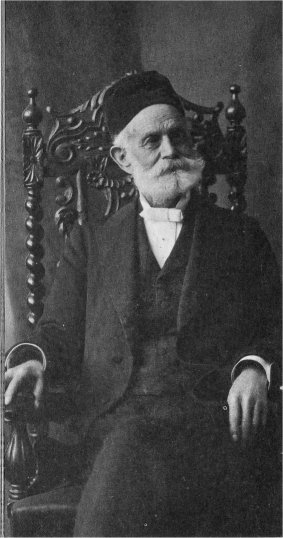
—Taber James Mason Hutchings[click to enlarge] |
3. A granite stone stands next surrounded with an iron fence. The stone reads, “William Bonney Atkinson, born in Yosemite June 25, 1898, died April 15, 1902.” This youngster, nearly four years old, was the youngest of three children of Charles and Nell Atkinson. His father was an employee of the State of California, which was managing the Yosemite Grant at that time.
4 and 5. A large rugged piece of granite and a trim stone cross mark the graves of the Hutchings family. Here lie James Mason Hutchings, his second wife Agusta L. Hutchings, and his daughter Florence, the first white child born in Yosemite Valley.
Mr. Hutchings was born in Towchester, Northamptonshire, England on February 10, 1824. A capable and prolific writer, he did much to bring to the world the news of Yosemite’s beauty. It was he who organized the first tourist visit to Yosemite Valley in 1855. This group included Thomas Ayers who drew the sketches for the first Yosemite illustrations ever published.
Hutchings had worked on a newspaper in New York until he heard of the gold rush in California. After several attempts to secure riches in the hills of the Mother Lode he turned again to literary pursuits and was successful. He is credited with many writings, including The Miner’s Ten Commandments, a letter sheet which sold nearly 100,000 copies about 1853; Guide to the Yo Semite Valley and the Big Trees. He also published for several years Hutchings California Magazine. It was while gathering material for this magazine that Hutchings made his 1855 trip into Yosemite.
Hutchings published his magazine until June 1861, when he was forced to discontinue it because of ill health. This situation prompted him to move to Yosemite and take up a life that was closer to the out-of-doors. He came into the valley in 1862 and in 1863 purchased the frame “Upper House” hotel, near the present Sentinel Bridge. He moved his family into the valley the following year. The family home was on the warm side of the valley, near the foot of Yosemite Falls. Conditions were primitive at the hotel at first, and he began to make improvements. In 1869 he built a saw mill along Yosemite Creek (operated for a time by John Muir). This provided boards for partitioning the rooms, replacing the muslin used before that time, and for other improvements.
In 1864 the Congress and President Lincoln established the Yosemite Grant, setting this beautiful place apart for all time. After living for a time in San Francisco, Hutchings returned to Yosemite in 1880 to succeed Galen Clark as Guardian of the Yosemite Grant. It was shortly after this that Hutchings wrote and published his most famous book In the Heart of the Sierras. In 1902 as he and his wife were making their way down the old Big Oak Flat Road the team became frightened and bolted. Both Hutchings and his wife were thrown from the wagon and injured. Hutchings died a few moments later in the arms of his wife.
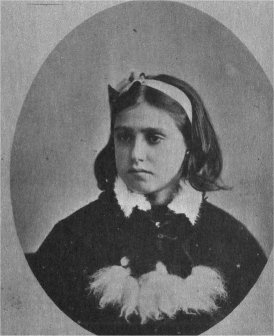
Florence Hutchings [click to enlarge] |
Popular and vivacious Florence Hutchings was only 17 when she died in 1881. Her funeral, like her father’s, was held in the Big Tree Room of the Barnard Hotel called, before Barnard’s time, “The Hutchings House.” Agusta Hutchings followed Florence by only a few weeks.
6. Behind you is the grave of Effie Crippen who died at 14 years of age. She was the youngest of four daughters of Joshua D. Crippen, sheriff of Mariposa County from 1857 until his death in 1870. His widow married John K. Barnard, who operated the former Hutchings Hotel from 1877 to 1892. He was forcibly evicted on May 11, 1893, after litigation that reached the State Supreme Court. Florence Hutchings and a group of her friends sang at Effie’s funeral. Florence died only a few weeks later.
7. Mrs. Laura Cannon and her husband were visitors to Yosemite, staying at the Stoneman House at the time she died, the summer of 1895. Charley Atkinson made her coffin and may have read the grave-side services as he often did.
8. Thomas Glynn and his wife Elizabeth were from Massachusetts. He was a currier by trade and died in the Valley on December 19, 1881. Galen Clark officiated at his funeral. Glynn was a veteran of the Mexican War. His wife was an excellent cook and for a time operated the hotel at Glacier Point. She was a neighbor of the Degnans for many years.
Between the graves of Thomas Glynn and Albert May was the old well, dug by Galen Clark to furnish water to keep the graves green. It was fitted with a hand pump with an equalizing air chamber. Operating this pump provided harmless fun for many of the children living in the Valley.
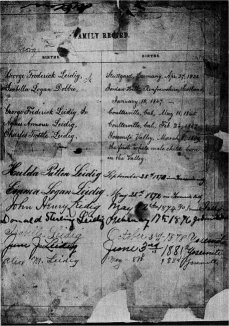
—L. V. Degnan Leidig Family Record[click to enlarge] |
9. Agnes Armour Leidig was the second of the eleven Leidig children, not two years old when she died. Her parents were pioneer hotel keepers in the Valley. She was born in Coulterville, February 24, 1867 and died in James Lamon’s winter cabin in Yosemite Valley on December 21, 1868. She was first buried near the present site of the Ahwahnee Hotel. When she died her mother was the only white woman in the valley and there were only four white men. The third Leidig child, Charles, was the first white boy born in Yosemite Valley (see illustration). John Henry (“Jack”) now in his 80s is the only survivor of the eleven Leidig children. He furnished much valuable information for this guide.
10. Albert May was a carpenter and caretaker for Mr. A. G. Black. Black’s Hotel was near the base of the Four Mile Trail.
11. James Chenowith Lamon lies beneath the tall granite spire with the stone and chain fence. Lamon, a generous and kindly man, was the first to build a cabin in Yosemite and to stay through the winter. This he did in 1861-1862. The apple orchard near the Camp Curry parking area was planted by Lamon. His cabin was near Camp 12, and the fruit from his trees and his excellent vegetables were welcomed by the tired and hot visitor. A letter from Yosemite dated December 10, 1875 and published in the Mariposa Gazette has this to say about the monument over his grave:
“Wending my way home I happened to pass the stand of John Conway, who is at present engaged in putting the finishing touches on the beautiful monument erected to the memory of J. C. Lamon, the old pioneer. This beautiful tribute is being erected by the heirs at a cost of $1,500. Mr. Galen Clark, the executor of the will is superintending the work, which is being done in a thorough and workmanlike manner. The rock used is an elegant piece of white granite taken from one of the “Three Graces”. It comprises three pieces, base, die and shaft; is 3 1/4 feet square at the base, and 12 feet high, and will be raised onto a solid piece of masonry, and when in place will be 20 feet high. It has a beautiful polish, and bears the following inscription:
J. C. LAMON
A native of Virginia,
The Pioneer Settler of Yo Semite,
Died 22d of May, 1875,
Aged 58 Years.
12. Next to Lamon’s grave is a simple rough stone with the name Galen Clark carved upon it. The dates show him to have lived to the ripe old age of 96. This is remarkable for a man who was, according to his doctor, destined to have a short life. Galen Clark is remarkable in more ways than this, however. In a handwritten manuscript written by Clark in June 1880, titled “Reminiscences of Galen Clark, Guardian of Yosemite Valley” in the Bancroft Library of the University of California, he says he left New York for
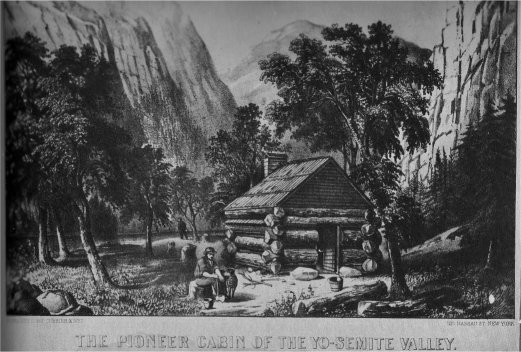
James C. Lamon and his cabin, Yosemite Valley. [click to enlarge] |
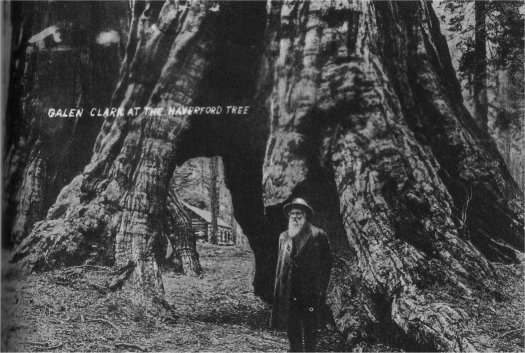
[click to enlarge] |
Galen Clark was an outstanding mountaineer. His explorations resulted in his entering the Mariposa Grove of Giant Sequoias in 1857. When the Yosemite Grant was established by the Congress the first Board of Commissioners delegated him as guardian in 1866. He was succeeded by Hutchings in 1880, but he again served in that capacity from 1889 to 1896. Clark for a time drove the first wheeled vehicle in Yosemite Valley, a wagon which was taken apart into mule loads, then reassembled in the valley. (It may be seen at the Wawona Pioneer Village). He carved his name upon this stone for his grave and planted six sequoias to stand about it. Five are still standing. His nephews carved the dates upon the stone.
Mr. & Mrs. George Fiske
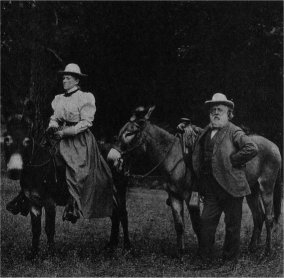
[click to enlarge] |
13 and 14. George Fiske, a native of Massachusetts, was a pioneer photographer in Yosemite in the late 1800’s and early 1900’s. He and his wife are buried here. His studio and home were located near the river, not far from the base of the Four Mile Trail. He was noted for his fine photographs. Mrs. Fiske was a member of an excursion that visited the Valley about 1900. She, also from Massachusetts, purchased a photograph from Fiske. This led to a romance and their eventual marriage.
15. Hazel Caroline Meyer was the daughter of George and Lizzie Meyer, pioneer settlers in Mariposa County at the Big Meadows ranch, near the park boundary. She died at the age of three. Her brother, Horace, is a respected resident of Mariposa County. Lizzie Meyer was the niece of James McCauley, builder of the Four Mile Trail to Glacier Point.
16. At the north end of this row of graves are those of Rose and Gabriel Sovulewski. Gabriel was born in Poland and came to America at the age of 16. He enlisted in the Army and it was while in the service that he came in contact with the National Parks. In 1895, 1896, and 1897 he served as Sergeant. under Capt. Alex. Rodgers and Lt. Col. S. B. M. Young, the military superintendents during those years. During this time he was in Troop K of the 4th Cavalry. The United States Army administered and patrolled the park from 1891, a year after its creation as a National Park, until 1914, when administration was turned over to civilian employees. In 1916 the National Park Service was created.
Sovulewski continued as a civilian, serving in the park the year around, as administrator during the absence of military superiors, and for a time as acting superintendent. His particular interest was in the trails. Many of the 740-odd miles of trails in Yosemite were planned and laid out by him. Thus he was a keystone in park administration until his retirement in 1936.
17. Rose Sovulewski lived in the valley twenty-two years. She died in August 1928 at the age of fifty-four. Descendants of the Sovulewskis live in Yosemite today.
18. Leonidas G. (“Dick”) Whorton was shot and killed at his Cascades house by Abel Mann on April 4, 1887. Whorton was at one time an important personage in Yosemite Valley. He was Justice of the Peace, Grand Marshal of the parades, and the like. In 1870 he and Peter Gordon were partners in the “Lake House” at Mirror Lake. He also owned 80 acres at Cascades, some seven miles down the Merced canyon from here. Several factors had a part in the killing — a woman and the Civil War included. Mann was tried for murder in the Mariposa County Superior Court and was acquitted. Some years later he tried to kill his wife by cutting her throat. He was said to have committed suicide when surrounded by a posse.
19. According to Jack Leidig, John Hamilton was a guide, among other things, who had a cabin and stockade in El Capitan Meadow, not far from the bridge. He also lived in back of Folsom Hall, which once stood on the south bank of the Merced, near the present Swinging Bridge. It was here that he died, perhaps in July or August of 1882.
George Anderson climbing Half Dome - 1875
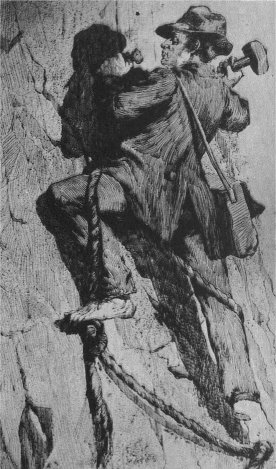
[click to enlarge] |
20. The next grave is a small, simple stone that could be easily passed by. It has carved upon it “George Anderson.” This is the grave of the brave Scot who was the first to scale Half Dome. Prior to October 1875 it was considered unclimable. Anderson drilled holes and inserted eye-bolts, standing on each bolt as he drilled the next, until he made the top. He was one of the early ones to start Yosemite off as a Mecca for rock climbers in the United States, and indeed most of the world. Anderson built the trail from Happy Isles to Vernal Fall in 1882 and we are indebted for his services. His cabin is now at the Wawona Pioneer Village.
21. Little is known of the man named Wood. From Jack Leidig we learn that he was from Knight’s Ferry and that he was watching cattle for J. B. Curtin at the time of his death at Tamarack Flat.
22. G. B. Cavagnaro’s grave is marked with a fine stone marker and iron fence. Mr. Cavagnaro was a storekeeper in the Old Village here in the valley. He was said to handle everything from a box of paper collars to a side of bacon. Visitors of that early day had to be supplied even as they do today, and here was the man to do it.
23. The marble headstone marking the grave of John C. Anderson must have been brought into the valley at considerable effort. No marble exists here. The headstone tells us that he was killed by a horse. Anderson, a stage driver, was buried at first at the base of the Four Mile Trail near the residence of George Fiske. Later the grave was moved here. Tradition says that his locust wood switch was stuck in the ground to mark his grave; that it took root and that the locust trees now common in the valley (there are several here in the cemetery) are descendants of Anderson’s switch.
24. Walter Coyle and his family were camped near Yosemite Creek when their baby died. Their home was near Groveland. Mr. Coyle worked in Yosemite Valley on and off for many years, sometimes for the State, sometimes for Coffman and Kenney.
25. The tall, rough stone belongs to Albert Baldwin Glasscock, who took over the operation of Barnard’s naming it the Sentinel Hotel. It stood south of the Merced River just downstream from the Sentinel Bridge. Glasscock was operating the hotel when he contracted his fatal illness and died there. The gravestone was hauled from the vicinity of Bridalveil Falls. The lettering was done by Davis B. Lawler, an employee of the State.
26. James Morgan was laid to rest only a few days after Sadie Schaeffer. For nearly thirty-five years flowers were sent by his family each Memorial Day to be placed on his grave. His wife was later buried beside him.
27. Arriving once again at the south end of the cemetery we find a granite shaft belonging to Sadie Schaeffer. The official report of the coroner’s jury, in the Yosemite Museum, states that she was “about 28 years of age” and employed as a waitress by J. B. Cook at the Sentinel Hotel. Johnny van Campen, a carpenter who worked for A. H. Washburn at Wawona, was working in the Valley the summer of 1901. He built a small canvas boat in which he took Sadie for a ride on the Merced River. They were swept into the rapids near the El Capitan Bridge and Sadie was drowned. Her funeral was attended by many friends, including one of the authors (LVD).
28. Forest S. Townsley was Yosemite’s Chief Ranger when he died of a heart attack on August 11, 1943 near a lake which now bears his name. He was born in 1882 in Greeley Center, Nebraska. He came to Yosemite as a ranger in 1913, and was promoted to Chief Ranger in 1916. His skill as a taxidermist brought special recognition from Stephen T. Mather, first director of the National Park Service. Chief Townsley displayed his mounts in his office when it was in the Old Village. Later a museum was set up in the cabin which was Chris Jorgensen’s studio. In 1926 the Yosemite Museum was built in its present location. Thus Forest Townsley gave the Yosemite Museum its beginning. He was devoted to the Service, and his son, John Townsley, is a ranger continuing in his father’s tradition.
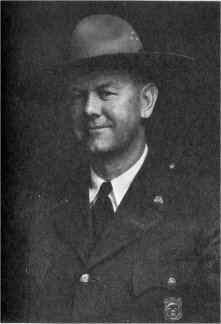
—Anderson Chief Park Ranger Forest S. Townsley. [click to enlarge] |
29. The identity of “A Boy” has been lost. The Mariposa Free Press carried on June 24, 1870 the story of the drowning of a boy, John Morgan Bennett, son of Captain R. H. Bennett, while attempting to cross a branch of the Merced River in Yosemite Valley on a mule. Jack Leidig says that the boy was the first person to be buried in the cemetery. Why this site was chosen we do not know.
30. “Frenchman”, next in the row, was probably Etienne Manet, who used to sell vegetables which he grew in the upper Lamon orchard. He lived in a cabin at the northeast corner of the lower Lamon orchard now the Camp Curry parking area. The Commissioners granted him a permit to operate the orchard in 1889. Said to have been slightly demented, he was, according to Jack Leidig, found dead in his cabin.
|
Yosemite hostelries such as the Sentinel Hotel provided employment for many of Yosemite’s
pioneers. This site was cleared in 1939-1940. 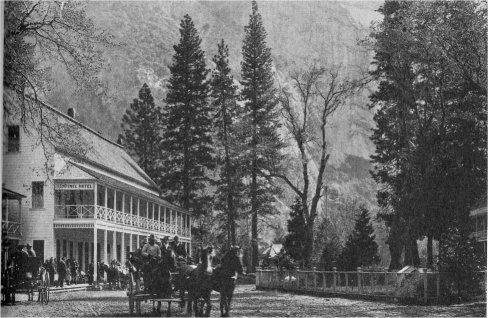
[click to enlarge] |
31. The next marker has the name Woolcock on it. Nothing has been learned about this man.*
*Information recently found in the July 3, 1874, Mariposa Gazette informs us of the following: “Fatal Accident — Henry Woolcock, o miner, who formerly worked in Mariposa, but who has been recently employed on the Coulterville and Yo Semite wagon road, fell from a log at a crossing on Cascade Creek, below Yo Semite Valley, on Sunday, June 22d, and hod his neck broken by the fall, which was about 12 feet. Not returning to the camp in season, search was made for him, and he was found lying in the bed of the stream, dead. Deceased was a native of England, and about sixty years of age.”
32. Only a large flat rock which formed one wall of Boston’s cabin remains at Cascades to remind us of the tragic story of his murder. Concerning it the Mariposa Gazette carried an item on August 21, 1875:
“On August 12, Bolton’s toll house at the Cascades below the Yosemite Valley was burned to the ground. George Ezra Boston; toll collector, was burned to death. A notorious Indian scoundrel, Piute George, is suspected of setting the fire. Mr. Boston was a native of Virginia, age 50 years.”
A reliable account from Jules McCauley says that Boston had invited three Indians, including Piute George, then a fugitive, to eat with him. The four sat down to supper together and when finished Boston gathered the dishes. The Indians stood behind him and at the right moment shot him in the back, then cut his throat.
The station was burned. Piute George was finally enticed out of the rocks with liquor and subdued with buckshot. He was tried, found guilty, and sentenced to life imprisonment. He died years afterward in San Quentin Penitentiary.
33. McKenzie was a member of a camping party that visited the Valley, perhaps late in the summer of 1896. He died at their camp a little to the west of Galen Clark’s house, which formerly stood near the Swinging Bridge. One of the authors (LVD) was in the Valley at the time, and recalls the incident.
34. A. W. B. Madden died in 1883. He was a tourist perhaps visiting from England, who died while staying at the Sentinel Hotel. A cross that marked his grave disappeared in 1933 and was later replaced by a wooden marker. Nothing else is known of him.
[Editor’s note: Carolyn Feroben transcribed this obituary from the May 27, 1897 New Orleans Daily Picayune (2007): “Died in Yosemite Valley—San Franicsco, May 24—Colonel G. A. Madden, of the British army, stationed in India, returned yesterday from the Yosemite, but without his brother, who accompanied him on his trip there somewhat over a week ago. The brother of Madden, a well-to-do tea mercant[sic] of Calcutta, died suddenly at Yosemite on Monday list[sic] and the remains, which would nt bear shipment to this city, were interred in the cemterery in the valley. Colonel Madden and his brother were on their way to London to attend the jubilee of the queen. The survivor will continue on his way to England, as he is under order to be there early in June.” —dea.]
Cremation was practiced by the Ahwahneechees living in pre-discovery Yosemite. The last ceremony of this kind in the Valley was upon the death of a nephew of Chief One-Eye Dick, killed in a hunting accident about 1873. The cremating grounds were directly across the road from the old Leidig Hotel, near the base of Sentinel Rock, so the Leidigs were compulsory witnesses. (See Yosemite Nature Notes, V. 12, n. 9, 1933).
The earliest recorded Indian burial was that of Kosano, or Torch Bearer, father of Ta-bu-ce. More than 80 years old and not well, he died after a difficult trip through snow from his native Mono Lake about 1875. He was buried just south of the large rock that is seen near the southeast corner of the museum.
The following bits of information on the Indian graves in the cemetery were gathered from many sources, including interviews with Indians now living in Yosemite.
Ten of the grave markers are redwood boards that have been placed in recent times, while the eleventh is simply a granite boulder. The following accounts are headed by inscriptions exactly as they appear on the 11 markers:
35.
SALLY ANN
CASTAGNETTO
DIED
APRIL 10
1932
Sally Ann Dick Castagnetto was a fullblood Yosemite Indian. Her father was Indian Dick, and her mother was Mary Dick. Sally Ann was considered to be one of the most beautiful of Yosemite Indians. She was full of life and very talkative. Her first husband was one of the early miners by the name of Stegman. After he died she married Johnny Brown. Johnny Castagnetto operated the Hennessey ranch below El Portal, and sold vegetables to the people in Yosemite Valley. He became sick and moved to Coulterville where Sally Ann went to nurse him.
|
Sally Ann Castagnetto; Commissioner William W. Foote; Nancy; John Stevens, Guardian (in
background); unidentified visitor; Mrs. J. B. Cook, wife of the proprietor of the Sentinel Hotel; about 1903. —Courtesy of Jack Randolph 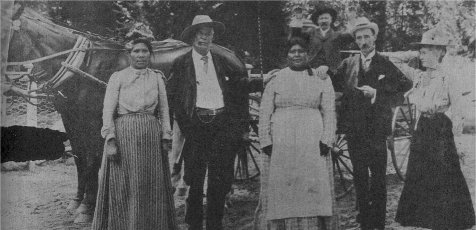
[click to enlarge] |
36.
MOTHER
OF
LUCY
PART
YOSEMITE
Very little knowledge seems to have been retained about the mother of Indian Lucy Brown. Early photographs of this lady show that she must have been extremely old at the time of her death.
37.
MAY
TOM
AGED 14
PIUTE
May Tom was the young niece of Ta-bu-ce (Maggie Howard). May was killed by a tree that fell on her while she was camped beside the trail northeast of Yosemite Point with Ta-bu-ce. The tree also hit Ta-bu-ce and broke her leg, which never did heal properly, so that she walked with a slight limp the rest of her life. One of the writers (LVD) attended her funeral, perhaps in 1905.
38.
MAY
DICK
YOSEMITE
May Dick, the mother of Sally Ann Dick Castagnetto, was a fullblood Yosemite Indian. Her husband was Indian Dick, who worked providing wood for many of the early settlers in Yosemite Valley. He was one of the first woodcutters to use a power saw in this area, thereby outdoing all of his rivals in that business.
39.
GRANDMOTHER
OF
LUCY TELLES
Suzie Sam, Lucy Telles’ grandmother, was a Yosemite Indian, born in Yosemite Valley. Her husband was Captain Sam. Old Captain Sam was employed by Camp Curry and the Sentinel Hotel to supply them with fish. Many of the early Indians were well versed in their abilities to catch trout, but they would not reveal the methods that made them so successful. Lucy Telles’ grandmother died in the month of August, about 1904.
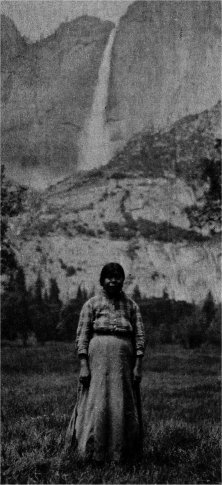
—Boyson Suzie[click to enlarge] |
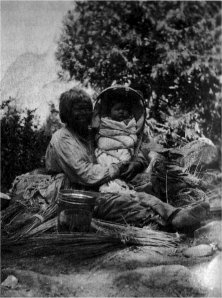
—Boysen Lucy Brown and herGreat-Granddaughter, Alice [click to enlarge] |
40.
LUCY
DIED
1920
PART
YOSEMITE
Lucy Brown, or Indian Lucy, said to be nearly 120 at the time of her death, was one of the last of the original Indians who had been found in Yosemite Valley at the time of its discovery by white men in 1851. She was the oldest of six generations the Brown family, many of when have lived most of their lives in Yosemite. Her husband was Bill Brown She was the cousin of Maria Lebrado, who was the last survivor of the original Yosemites. The date of Lucy’s death has been recorded in several documents to have been 1924.
41.
BILL
BROWN
DIED
1899
YOSEMITE
Bill Brown, or Mono Tom Brown was the husband of Indian Lucy, father of Johnny, and grandfather of Chris Brown. He was one of the first Indians to be buried in the Yosemite Cemetery area. Jack Leidig says that his grave is actually some distance from the marker.
|
Bridgeport Tom, Mamie, Leona, baby Agnes Castro, Ida, and Lillian at the Old Indian Village
near the present Lewis Memorial Hospital. 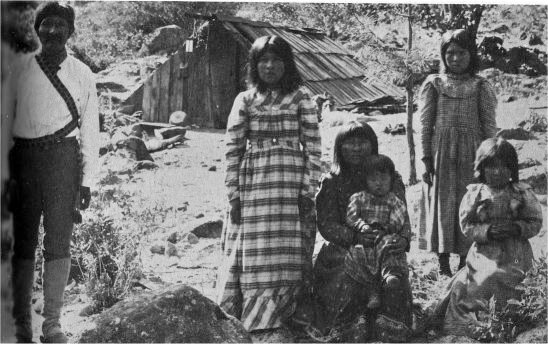
[click to enlarge] |
42.
LANCISCO
WILSON
DIED
1885
PIUTE
Lancisco was the father of Johnny Wilson. Lancisco’s Indian name was Tu-tok-a-nu-la, meaning El Capitan. He was one of the old chiefs of the Yosemites, aged approximately 115 years at the time of his death.
43.
JOHNNY
BROWN
DIED
1934
YOSEMITE
Johnny Brown was born about 1860, perhaps at Rancheria Flat near El Portal. He was married first to ‘Bally Ann Dick. His second wife was Lena Brown, and they had four children—Chris, Virgil, Alves, and Hazel. Chris Brown (Chief Lee-mee) was named after the very popular early Yosemite artist, Chris Jorgensen. One of the last Indian burial ceremonies of Yosemite Valley took place during Johnny Brown’s funeral. Chris Brown and Lizzie, last surviving Nutchu, performed the Indian rites at the burial.
44.
PETE
HILLIARD
1870—1934
Pete Hilliard was born in El Capitan Meadow in Yosemite Valley. He was part Yosemite. An old timer in the Valley, John Baptista Bacigalupi, told Laurence Degnan that Pete’s father was Chinese. He was intelligent and versatile and did work such as surveying. With Francisco Georgely he surveyed Bridgeport Tom’s place near Bloody Canyon when the latter first entered that region for farming. Pete lived most of his life in Yosemite Valley working for the Government. His sister, Louisa Westfall Hilliard, died recently, nearing 100 years of age.
45.
LOUISA
TOM
1956
The last marker is that of Louisa Tom, who died in 1956. She asked to be placed with her family, buried here. Her’s will probably be the last burial in this cemetery. Louisa Tom’s passing, at a probable age of more than 100 years, was marked by an old-time Indian “cry” by members of her family.
It is certain that there are graves lying outside of the cemetery. In the research library of the Yosemite Museum one will occasionally encounter references to unmarked and now forgotten graves. At least two of these are within a stone’s throw of this cemetery. One is that of a fallen and forgotten woman who became sick and died in her camp in Yosemite Valley. Many will remember Ta-bu-ce (Maggie Howard) who made acorn cakes for visitors not so long ago. Ta-bu-ce was buried with Indian ceremonies at Bishop, California late in January of 1947.
Lee-Mee (Chris Brown), who passed on the songs and dances of the Miwok people for many years died and was buried near Mariposa in 1956. His passing left no one to carry on the culture of Yosemite’s Indians.
|
The dances of Lee Mee (Chris Brown) and the sage remarks of Ta-bu-ce (Maggie Howard)
added to the enjoyment of many visitors. Former Park Naturalist Bert Harwell at right. —Anderson 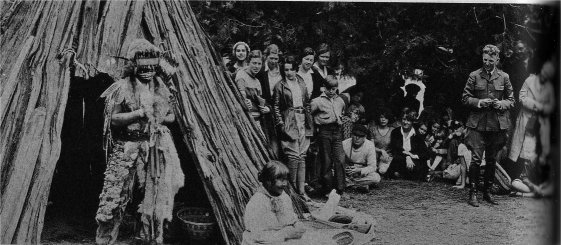
[click to enlarge] |
Before you leave, pause a moment to read a clipping from John Barnard’s scrapbook about the death of James Lamon. It is dated May 24, 1875.
“Friends and strangers joined in the procession which followed his remains to their final earthly rest. Under the branches of a gnarled old oak where the shadow of the cliffs that bound the great Yo Semite cataract at evening spreads its sombre pall, we made a grave for our old friend Lamon. The gray domes, rugged cliffs, and cloud-wreathed spires of a temple grander than any reared by human hands, stand like grim sentinels to guard the walls of his burial ground, and the deep toned music of the surging fall thunders a requiem forever over the mortal remains of that noblest work of God, an honest man.”
We hope you have enjoyed your walk through Yosemite’s Pioneer Cemetery. Perhaps turning back the pages of time for a little while has helped you forget some of the cares and worries of our more “modern” age, and gain an insight into some of the people who left a mark in this great National Park.
MANY OTHER INTERESTING FEATURES OF YOSEMITE NATIONAL PARK ARE EXPLAINED THROUGH SELF-GUIDING BOOKLETS. YOU ARE INVITED TO ENJOY THESE ALSO:
GUIDE TO MARIPOSA GROVE NATURE TRAIL — A guide to a nature trail through this famed grove of Big Trees.
AUTO TOUR OF YOSEMITE NATIONAL PARK — Many vistas and features are explained in this booklet, which includes all roads in the Park.
TRAIL GUIDE TO INSPIRATION POINT NATURE TRAIL — The Mariposa Battalion first saw Yosemite Valley from near this vantage point. The booklet tells you of this and other historic events and also identifies many plants along the trail.
GUIDE TO HAPPY ISLES NATURE CENTER — A pictorial guide to this interesting interpretive development.
A GUIDE TO THE YOSEMITE SEQUOIAS — All of the more interesting Big Trees are described in this self-guiding auto tour to the Mariposa Grove.
THE ABOVE SELF-GUIDING BOOKLETS ARE AVAILABLE AT THE MUSEUM AND AT THE STARTING-POINTS OF THE TRAILS.
|
Johnny Castagnetto, husband of Sally Ann, and his pack train brought fruit and vegetables
from the Hennessey Ranch in El Portal to Yosemite. 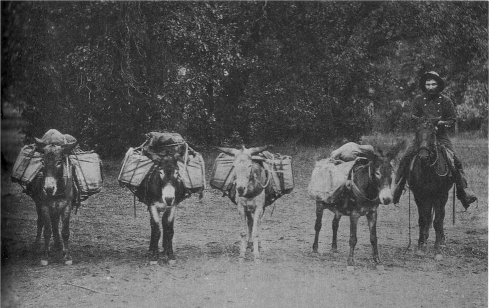
[click to enlarge] |
Laurence V. Degnan was born February 14, 1884. He is the son of Yosemite pioneers John and Bridget Degnan. In the 1890s his parents established a family-ran bakery in the Old Upper Village in Yosemite Valley. The family moved their deli to the new Yosemite Village in 1956. The new A-frame building bankrupted their family business and they sold the business to the Yosemite Park and Curry Company in 1974. Laurence Degnan died in San Francisco August 13, 1963. For more information, see “Degnan Bakery” and “John Degnan Bakery and Store,” in One Hundred Years in Yosemite (1947) by Carl P. Russell.
Richard R. “Dick” Jackson was a Ranger-Naturalist. He is briefly mentioned in Shirley Sargent’s Protecting Paradise (1998).
Lloyd W. Brubaker, Jr. was December 25, 1926 near Lancaster, Pennsylvania. He served in the Navy during World War II. He graduated from University of California, Berkeley in 1951. He was a Junior High School teacher and a Ranger-Naturalist. He also wrote a book Biological Science for the Eigth Grade (1957). He retired and lived in Ridgecrest, California and Baton Rouge, Louisiana. He was a ham radio operator. He died February 10, 2016 in Ridgecrest.
Lloyd W. Brubaker (c.1926-2016), Laurence V. Degnan (1884-1963), and Richard R. Jackson (-), Guide to the Pioneer Cemetery. Appeared as Yosemite Nature Notes 38(5):58-74 (1959). Illustrated. 24 cm. Saddle-stitched paper wrappers.
Additional information about the Pioneer Cemetery:
Digitized by Dan Anderson, April 2007,
from a copy at San Diego State University.
These files may be used for any non-commercial purpose,
provided this notice is left intact.
—Dan Anderson, www.yosemite.ca.us
| Ebook formats | No images: | Plain text zip | Plucker | HTML zip | Palm Doc | Palm zTXT | Sony LRF | Braille Grade 2 BRF |
| Images: | Plucker | iSilo | Kindle/Mobipocket |
| Online Library: | Title | Author | California | Geology | History | Indians | Muir | Mountaineering | Nature | Management |
http://www.yosemite.ca.us/library/pioneer_cemetery/